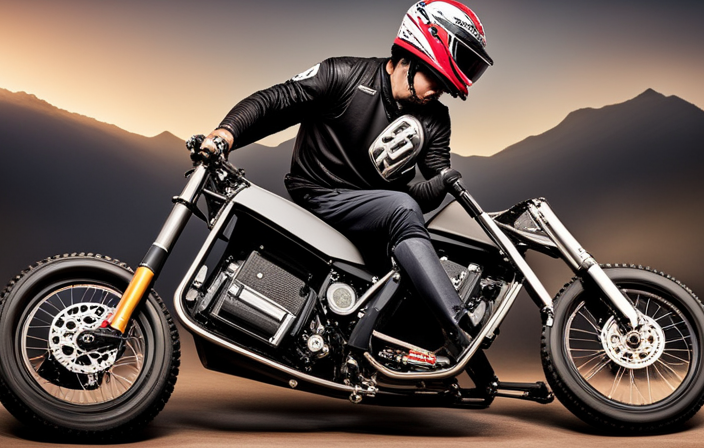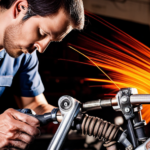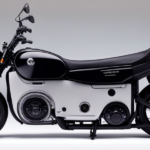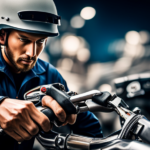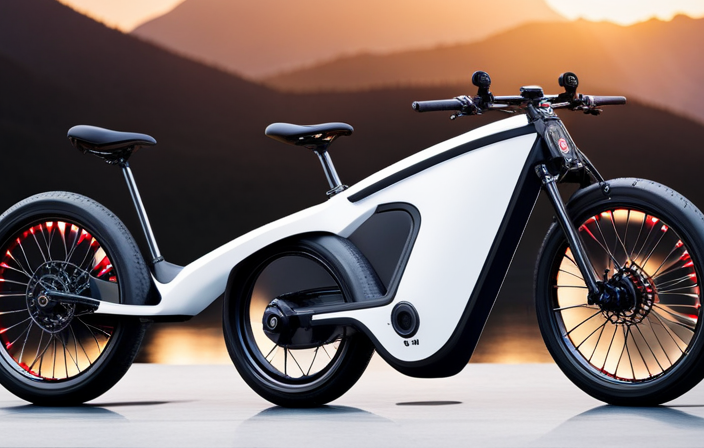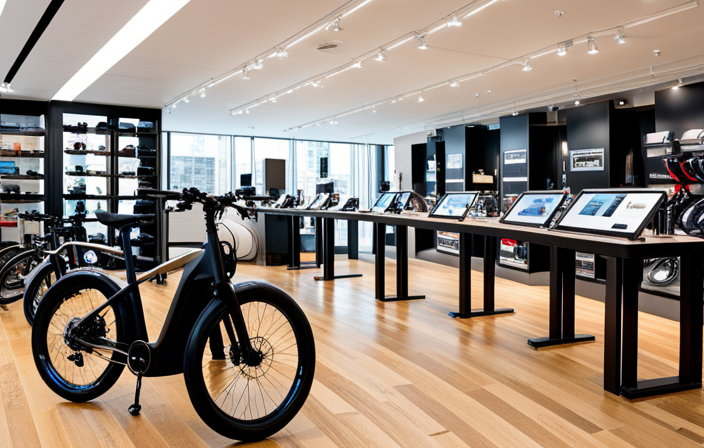I’m sure we’ve all had that sinking feeling when our electric start dirt bike won’t start. It’s like the world has stopped. But don’t worry, fellow riders, as I am here to help you through troubleshooting step by step.
In this article, we will explore various potential issues, from checking the battery and inspecting the starter motor to testing the ignition switch and examining the spark plug.
So, let’s dive in and get our beloved dirt bikes back on track!
Key Takeaways
- Visually inspect the battery for damage or corrosion and ensure that the battery terminals are securely connected and free of debris.
- Use a multimeter to test the battery voltage and charge the battery if it is weak or dead.
- Check the ignition switch and spark plug for proper functioning and replace them if necessary.
- Regularly maintain and clean the fuel system and air filter for optimal bike performance.
Check the Battery
You should first check if the battery is fully charged. When troubleshooting a dirt bike that won’t turn on, the battery is often the culprit. A common issue is a weak or dead battery, which can prevent the electric start from functioning properly. To determine if the battery is the problem, start by visually inspecting it for any signs of damage or corrosion. Make sure the battery terminals are securely connected and free of debris.
If everything looks fine, use a multimeter to test the battery voltage. A fully charged battery should read around 12.6 volts. Anything significantly lower could indicate a weak or dead battery. In this case, try charging the battery using a suitable charger. If the battery still won’t hold a charge, it may need to be replaced.
Now, if the battery is fully charged and still the dirt bike won’t turn on, it’s time to inspect the starter motor.
Inspect the Starter Motor
Check if the starter motor is functioning properly. To do this, start by inspecting the battery terminals. Ensure that they are clean and securely attached to the battery. Loose or corroded terminals can prevent the starter motor from receiving the necessary power to turn on.
If the terminals are in good condition, the next step is to troubleshoot the starter motor wiring. Begin by examining the wiring connections at the starter motor. Look for any loose or damaged wires that may be causing a poor connection. If everything appears to be in order, use a multimeter to check the continuity of the wiring. This will help identify any breaks or faults in the circuit.
Additionally, check the starter solenoid, which is responsible for engaging the starter motor. Make sure it is securely connected and functioning correctly. If necessary, consult the bike’s manual to locate the solenoid and understand its proper operation.
Test the Ignition Switch
To test the ignition switch, make sure it is securely attached and functioning properly. The ignition switch is a key component in starting your electric start dirt bike. If it is not working correctly, it can prevent the bike from turning on. Troubleshooting the ignition switch is an important step in diagnosing the issue.
Here is a table that outlines the steps to test the ignition switch:
| Step | Action |
|---|---|
| 1 | Check if the ignition switch is securely attached to the bike. |
| 2 | Inspect the wires connected to the ignition switch for any damage or loose connections. |
| 3 | Use a multimeter to test the continuity of the ignition switch. |
| 4 | If there is no continuity, the ignition switch may be faulty and needs to be replaced. |
| 5 | If the ignition switch passes all tests, move on to examining the spark plug. |
Examine the Spark Plug
Now let’s take a look at the spark plug to determine if it’s functioning properly. The spark plug is a crucial component in the combustion process of your dirt bike’s engine. It creates the spark needed to ignite the air-fuel mixture and power the engine. If there are any issues with the spark plug, it can lead to starting problems or even cause the engine to misfire.
To troubleshoot the spark plug, start by removing it from the engine using a spark plug wrench. Inspect the spark plug for any signs of damage, such as worn electrodes or a cracked porcelain insulator. If you notice any of these issues, it’s time to replace the spark plug.
Another common issue with spark plugs is carbon buildup. Over time, carbon deposits can accumulate on the electrodes, reducing the spark’s effectiveness. To clean the spark plug, use a wire brush or spark plug cleaner to remove the carbon deposits. Make sure to gap the spark plug to the manufacturer’s specifications before reinstalling it.
With the spark plug examined and either replaced or cleaned, we can now move on to verifying the fuel system. This step will help us identify any potential issues with the fuel delivery that could be preventing the engine from starting.
Verify the Fuel System
Take a moment to inspect the fuel system of your dirt bike to ensure that everything is operating correctly. The fuel system plays a crucial role in the performance of your bike, and any issues with it can lead to starting problems or poor engine performance.
Here are some troubleshooting tips and common issues to look out for:
-
Check the fuel level: Make sure your bike has enough fuel in the tank. Running out of fuel is a common mistake that can easily be avoided.
-
Inspect the fuel filter: A clogged fuel filter can restrict fuel flow and cause starting issues. Remove the filter and clean or replace it if necessary.
-
Examine the fuel lines: Look for any signs of damage or leaks in the fuel lines. Cracks or holes in the lines can lead to fuel supply problems and prevent your bike from starting.
-
Test the fuel pump: If your bike has a fuel pump, make sure it is functioning properly. A faulty fuel pump can cause fuel delivery issues and affect starting performance.
By ensuring that your fuel system is in good condition, you can improve the chances of your dirt bike starting smoothly.
Now, let’s move on to the next section and discuss how to clean or replace the air filter.
Clean or Replace the Air Filter
Make sure you clean or replace the air filter of your dirt bike regularly to maintain optimal engine performance. The air filter plays a crucial role in preventing dirt and debris from entering the engine, which can cause damage and affect its overall performance.
Over time, the air filter can become clogged with dirt and dust particles, reducing airflow and hindering combustion. To clean the air filter, remove it from the bike and gently tap it to remove loose debris. Then, wash it with a mild detergent and warm water, making sure to thoroughly rinse and allow it to dry completely before reinstalling. If the air filter is damaged or excessively dirty, it should be replaced.
Additionally, while addressing the air filter, it is also a good idea to replace the fuel filter and clean the carburetor. Both these components can become clogged or dirty, leading to fuel flow issues and poor engine performance. By regularly maintaining and cleaning these parts, you can ensure that your dirt bike runs smoothly and efficiently.
Now, let’s move on to checking the wiring connections.
Check the Wiring Connections
To ensure optimal performance, regularly check the wiring connections of your dirt bike. Troubleshooting electrical issues can be a daunting task, but with these tips, you’ll be able to identify and resolve common problems with ease.
Here are some troubleshooting tips to help you address common electrical issues:
-
Inspect the battery connections: Ensure that the battery terminals are secure and free from corrosion. Tighten any loose connections and clean the terminals if necessary.
-
Check the ignition switch: Make sure the ignition switch is in the proper position and functioning correctly. Sometimes, a faulty switch can prevent the bike from starting.
-
Examine the fuses: Inspect the fuses for any signs of damage or blown fuses. Replace any faulty fuses with the appropriate rating to restore electrical functionality.
-
Verify the wiring harness: Carefully inspect the wiring harness for any loose or damaged wires. Make sure all connections are secure and repair or replace any damaged wiring.
By regularly checking these wiring connections and addressing any issues, you can prevent electrical problems and ensure that your dirt bike starts reliably.
Now, let’s move on to the next section and inspect the kill switch.
Inspect the Kill Switch
The first step is checking if the kill switch is in the correct position. The kill switch is a safety feature that cuts off the engine power when activated. If it is accidentally turned off or in the wrong position, your dirt bike won’t start. To inspect the kill switch, locate it on the handlebars and make sure it is in the ‘ON’ position. If it is already in the correct position, move on to the next step.
Next, check the ignition coil. The ignition coil is responsible for generating the high voltage needed to ignite the fuel-air mixture in the engine cylinder. Inspect the ignition coil for any signs of damage or wear. If it appears damaged, it may need to be replaced.
After checking the ignition coil, inspect the carburetor. The carburetor mixes fuel and air in the correct proportions before it enters the engine. If the carburetor is dirty or clogged, it can prevent the engine from starting. Remove the carburetor and clean it thoroughly, ensuring that all the passages and jets are clear.
Now, let’s move on to examining the fuse.
Examine the Fuse
Now, let’s take a look at the fuse to see if it’s blown.
The fuse is a small device that protects the electrical system from damage caused by excessive current.
To examine the fuse, start by locating the fuse box on your dirt bike. It’s usually located near the battery or under the seat.
Once you’ve found the fuse box, open it and inspect the fuse. Look for any signs of damage, such as a broken filament or a charred appearance.
If the fuse appears to be blown, it’ll need to be replaced with a new one of the same rating.
It’s also a good idea to check the ignition coil and inspect the carburetor while you’re troubleshooting the electrical system.
The ignition coil is responsible for generating the spark that ignites the fuel mixture in the engine. If the ignition coil is faulty, it can prevent the engine from starting.
Additionally, a clogged or malfunctioning carburetor can also cause starting issues. Cleaning or repairing the carburetor may be necessary to get your dirt bike up and running again.
Now, let’s move on to the next step and test the voltage regulator.
Test the Voltage Regulator
First, check the voltage regulator by using a multimeter to test the output voltage. This is an essential step in troubleshooting electrical issues with your electric start dirt bike. The voltage regulator is responsible for regulating the electrical output from the battery and ensuring a consistent voltage supply to the various components of the bike.
To test the voltage regulator, start by setting your multimeter to the DC voltage setting. Connect the positive lead of the multimeter to the positive terminal of the battery and the negative lead to the output terminal of the voltage regulator. Start the bike and rev the engine slightly while monitoring the multimeter reading. The voltage should remain steady within the specified range.
If the voltage regulator is not functioning properly, it can lead to a range of common issues such as a weak or dead battery, electrical component failure, or difficulty starting the bike. If you find that the output voltage is not within the specified range, it is recommended to replace the voltage regulator to resolve the issue.
Next, we will move on to checking the starter solenoid, another potential cause for your electric start dirt bike not turning on.
Check the Starter Solenoid
To check the starter solenoid, you’ll need to use a multimeter to test the continuity of the solenoid’s terminals. The starter solenoid is an important component of the electrical system in your dirt bike, responsible for engaging the starter motor to start the engine. If your electric start dirt bike won’t turn on, the starter solenoid could be one of the common issues to troubleshoot.
Here are some troubleshooting tips to check the starter solenoid:
-
Disconnect the battery: Before working on the electrical system, it is essential to disconnect the battery to avoid any potential accidents or damage.
-
Locate the starter solenoid: The starter solenoid is usually located near the battery or starter motor. Refer to the dirt bike’s manual for specific instructions.
-
Test the continuity: Set your multimeter to the continuity mode and touch the probes to the solenoid’s terminals. If there is no continuity, it indicates a faulty solenoid that needs replacement.
-
Inspect the wiring connections: Check the wiring connections to ensure they are secure and free from corrosion or damage. Tighten any loose connections and clean any corrosion if found.
Inspect the Starter Relay
The starter relay is responsible for transmitting electrical power from the battery to the starter solenoid. If your electric start dirt bike won’t turn on, one possible issue could be a faulty starter relay.
To diagnose this problem, start by checking the ignition coil and inspecting the carburetor. The ignition coil is responsible for generating the high voltage needed to ignite the fuel mixture in the engine. A faulty ignition coil can prevent the spark plug from firing, resulting in the bike not starting.
Inspecting the carburetor is also crucial, as a clogged or dirty carburetor can prevent the engine from receiving the proper fuel-air mixture.
If both the ignition coil and carburetor are in good condition, it’s time to move on and verify the kickstand safety switch. This safety switch is designed to prevent the bike from starting if the kickstand is down. Ensure that the kickstand is fully retracted and that the switch is functioning correctly.
Verify the Kickstand Safety Switch
Make sure you fully retract the kickstand and ensure that the switch is functioning correctly.
When troubleshooting an electric start dirt bike that won’t turn on, it’s important to consider the kickstand safety switch as a potential culprit. The kickstand safety switch is designed to prevent accidental engagement of the motor while the kickstand is down.
To verify the functionality of this switch, start by retracting the kickstand completely. Next, check the clutch lever. The bike will only start if the clutch lever is pulled in. If the lever is loose or not engaging properly, it may prevent the bike from starting.
Once you’ve confirmed the clutch lever is in good working order, move on to the sidestand switch. This switch is typically located near the kickstand and can sometimes become faulty. Inspect the switch for any visible damage or loose connections. If everything appears to be in order, you can move on to testing the neutral safety switch.
Now, let’s test the neutral safety switch.
Test the Neutral Safety Switch
After verifying the kickstand safety switch, the next step is to test the neutral safety switch. This switch ensures that the bike can only be started when it is in neutral, preventing accidental starts while the bike is in gear. If the neutral safety switch is malfunctioning, it can cause the electric start dirt bike to refuse to turn on.
To test the neutral safety switch, follow these steps:
-
Locate the neutral safety switch on your bike. It is usually located near the transmission and is connected to the gear selector.
-
Start by checking the wiring connections. Ensure that the wires are securely connected and free from any damage or corrosion.
-
Use a multimeter to test the switch for continuity. Connect the multimeter probes to the switch terminals and shift the bike into neutral. If there is no continuity, the switch may need to be replaced.
-
If the switch passes the continuity test, check for voltage at the switch while the bike is in neutral. If there is no voltage, there may be an issue with the electrical system that requires further troubleshooting.
Regular maintenance is crucial to prevent electrical issues like a malfunctioning neutral safety switch. Troubleshooting common electrical issues can help diagnose and fix the problem. However, if these steps do not resolve the issue, it is recommended to seek professional help to avoid further damage or safety risks.
Seek Professional Help
To avoid further damage or safety risks, it’s best to get professional help if you’re unable to resolve the issue with your malfunctioning neutral safety switch. Troubleshooting common issues with electric start dirt bikes can sometimes be challenging, especially when it comes to complicated components like the neutral safety switch. While there are certain tips for maintaining the electric start system on dirt bikes, some problems may require the expertise of a professional.
When your electric start dirt bike won’t turn on despite your best efforts, seeking professional help is crucial. A trained technician will have the necessary knowledge and experience to diagnose and fix the problem accurately. They can perform thorough diagnostics to identify the root cause of the issue and provide the appropriate solution. This can save you time, money, and frustration in the long run.
Additionally, professionals have access to specialized tools and equipment that may not be readily available to the average person. This can ensure a more efficient and effective repair process. They can also provide valuable advice and tips for maintaining the electric start system on your dirt bike, helping you avoid future problems.
Frequently Asked Questions
How do I check the wiring connections on my electric start dirt bike?
To check the wiring connections on my electric start dirt bike, I would start by inspecting the battery connections for any loose or corroded terminals. Then, I would troubleshoot the ignition switch to ensure it is functioning properly.
What should I do if the kickstand safety switch is not working properly?
If the kickstand safety switch is not working properly, I would start by troubleshooting the kickstand malfunction. I would check the switch for any loose connections, test it with a multimeter, and if necessary, replace the switch to ensure proper functionality.
How can I test the neutral safety switch on my dirt bike?
To test the neutral safety switch on your dirt bike, start by checking the battery voltage to ensure it has enough power. Then, test the relay switch by using a multimeter to check for continuity.
What steps should I take if I suspect a problem with the voltage regulator?
If suspecting a problem with the voltage regulator, I would first check its output using a multimeter. If the readings are abnormal, further troubleshooting electrical issues would be necessary to identify and address the root cause.
When should I seek professional help for my electric start dirt bike that won’t turn on?
If I have exhausted all troubleshooting steps and my electric start dirt bike still won’t turn on, it is time to seek professional help. They have the expertise and tools to diagnose and fix the problem.
Conclusion
In conclusion, when faced with the frustrating situation of an electric start dirt bike that won’t turn on, it is important to systematically troubleshoot the possible causes.
By checking the battery, inspecting the starter motor and ignition switch, examining the spark plug, verifying the fuel system, inspecting the starter relay, and testing the kickstand and neutral safety switches, you can narrow down the issue and hopefully find a solution.
Remember, seeking professional help is always an option if needed.
Did you know that approximately 30% of electric start dirt bike issues are caused by a faulty ignition switch? By thoroughly examining this component, you can increase your chances of resolving the problem.
